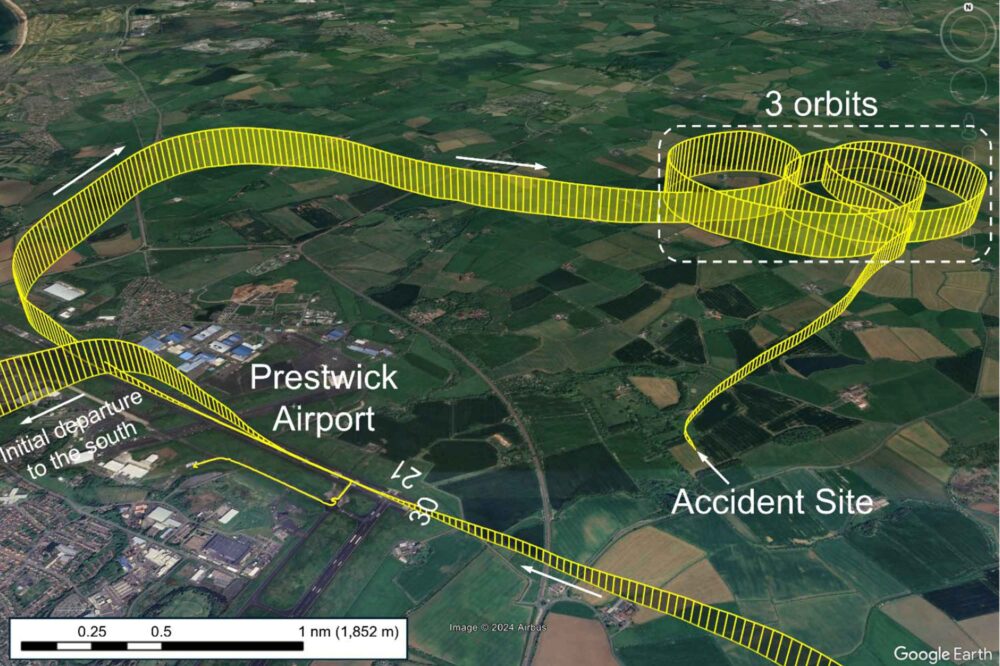Carb ice isn’t just for winter – it can happen almost any time – and it’s the probable cause of a serious accident for two pilots flying a Piper PA-28 in April, according to an AAIB report issued last week.
The accident took place in April this year 1.5 miles from Prestwick Airport. It was a currency checkflight for the holder of a Light Aircraft Pilot’s Licence (LAPL) with the club’s Chief Flying Instructor.
The AAIB report says, “The weather was generally fine at Prestwick on the day of the accident. The airfield weather report at 1550 hrs gave the conditions as follows: wind 250° at 10 kt, visibility greater than 10 km, cloud base 3,000 ft amsl, QHN 1024 hPa, temperature 11°C and dewpoint 5°C.

Carb icing risk chart. Image: AAIB/CAA SSL 14
“The temperature and dewpoint combination plotted on a CAA carburettor icing risk chart from the CAA’s Safety Sense Leaflet (SSL) 14 – Piston Engine Icing indicates the conditions of the day would have created a serious risk of carburettor icing at any power.
“While the aircraft was on a right base leg for an approach to Runway 30 at Prestwick Airport, ATC lost visual and radio contact. The aircraft had suffered a power loss and established a glide descent.
“The aircraft hit a tree during the latter stages of the forced landing, and subsequently struck the ground vertically nose-down. Both of those on board sustained serious injuries.”
The accident was further complicated with the CFI not having a current CAA medical certificate, and could therefore only be aboard the aircraft as a passenger.
As the accident happened
The plan was to fly for around one hour, conduct some general handling exercises to the south of the airport, including stalling and practice forced landings, and then return for three circuits. Both pilots recalled using carburettor heat during these exercises.
After one landing at Prestwick, the PA-28 took off again and entered a right-hand circuit.
On the downwind leg ATC asked the aircraft to enter an orbit to allow spacing for [an Airbus] A320 to make an approach to Runway 30; this is a common procedure at Prestwick.
After three orbits the aircraft was cleared to right base by ATC and directed to report Final. The call was acknowledged by the pilot and there was no indication of stress in his voice.
During the RTF exchange the ATC controller was visual with the aircraft as it rolled out of its final orbit toward a right base track. Following the exchange the tower controller turned around to look at the A320 in the left hand circuit while passing a message to that aircraft. When they turned back the tower controller could no longer see G-BVNS.
Toward the end of the last orbit the PIC had allowed the aircraft to descend to approximately 800ft amsl. As the aircraft rolled out on a base leg track, both those on board recalled that the engine had run down.
The CFI believed that the pilot in command had failed to notice the engine issue, called “I have control” and took control. He established the aircraft in the glide and looking ahead could see Runway 21 and the SAR hangar near the threshold of the disused Runway 25 at Prestwick. His initial thought was to attempt glide to that runway.
However, in his own words he soon realised that the airfield “was moving up the windscreen” and that it would be out of gliding range.
After taking control he directed the PIC to change the fuel tank selection, which he did. Although the CFI was on the right side of the aircraft, he did not feel there were any suitable landing options to the right but “saw a patch of open ground to the left.” The CFI considered a Mayday call but decided to concentrate on the forced landing.
In the latter stages he initiated a left turn to align with the longest axis of the landing area but saw trees that he considered would obstruct the aircraft’s final approach. He described raising the nose to clear the trees. The aircraft reduced speed and, whilst he did not recall hearing the stall warner, he described the aircraft as being in light buffet.
The aircraft struck the top of a tree in a left banked attitude, which arrested the forward speed of the aircraft, causing it to roll and yaw left, and pitch down. The aircraft struck the ground vertically nose-down.
The PIC recalled completing the downwind checks, believing he used carburettor heat, and conducting the orbits downwind. s he prepared for a descent towards the airfield, he recalled the engine rpm indication reducing to around 500. He recalled that the CFI said something but could not remember what was said.
Ahead he saw trees with an area of green beyond. He recalled that the CFI pumped the throttle, but that the engine did not recover. His last recollection of the flight was the nose being raised with the aircraft in a “right banked” attitude. Then the aircraft was on the ground. He believed that he had been flying the aircraft.
Conclusion
The engine most likely stopped because of carburettor icing and a forced landing ensued. The aircraft struck trees during the latter stages of the approach to the forced landing and control was lost. Both occupants survived but sustained severe injuries.
Download and read the full report here
Download CAA Safety Sense leaflet SSL14 on Piston Engine Icing













